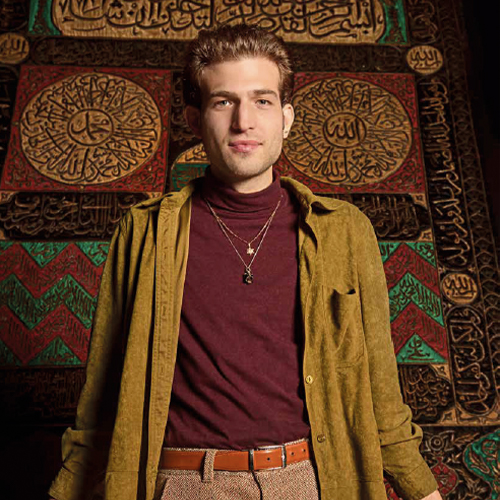
‘OMG, you’re Jewish, and now you’re queer too?!’
Jewish and queer — Photography: Jasmine de Vries
How do we navigate the waters of identity politics? Do we always know who we are? Is identity fixed once we claim a label? Or is it a process of becoming, of self-fashioning, and of perpetual reclamation? When you think of your gender, your culture, and your religion, where do you draw the line between ’knowing’ your identity and constructing it?
These questions flood my mind as I swim through the river that is self-discovery. And in my case, the answer is always drowning in complexities. I often struggle with the thought that my Jewishness and gender non-conformity cannot exist all at once. And this feeling is amplified when it comes to understanding how one’s gender and culturally religious upbringing can coexist in the same space. It’s like trying to force together two miss-matched pieces of a puzzle. But I opened my mind to the possibility that parts of my identity are not puzzle pieces, but rather, they are building blocks.
‘Trans and non-binary folks share a similar qualm with the Jewish community’
There are many moments that expose me to the complexity of my intersecting identities. Here’s one: I stood before the security checkpoint at John F. Kennedy Airport. My parents were seeing me off as I embarked on my study abroad journey to The Netherlands. I was beyond excited, incredibly anxious, and was itching to apply my lip gloss after they left. My widely racing thoughts began to narrow as my mother tucked my Magen David into my t-shirt, “I told you not to take that with you,” she said. As they left, I made my way through security, yanking my necklace from my layers and applying a thin layer of drugstore lip-gloss. And I felt more like myself.
Trans and non-binary folks share a similar qualm with the Jewish community: both associate an increase in visibility, with an increase in identity-based violence. Jews have to hide their practice, their culture, and their religion to appease their oppressors, just as queer folks put their identities in a box to appease theirs. There is a degree to which being invisible assumes one’s utmost safety, whether GNC folks feel compelled to present as their assigned gender, or whether one adamantly camouflages their religious identity. This is precisely why my mother wanted me to keep my Jewish identity in the shadows, and precisely why I didn’t feel safe to apply lip gloss in front of her. In my eyes and my experience, these two struggles are irrevocably linked.
As I was coming out as non-binary, I struggled with reconciling my experience with gender and my staunchly ingrained Jewish identity. As I knew it at the time, my queerness did not fit into my understanding of traditional Jewry, especially in terms of the gendered spaces and practices, my cultures persistent homophobia, and the like. And at the same time, the queer spaces I found myself in were vehemently anti-organized religion. So, how could I possibly queerify my Judaism if both spaces rejected the other’s politics? In the name of preserving my queerness, I repressed my Jewishness. I took off my Magen David necklace, quit practicing, and refused to step foot in a synagogue. Many queer Jews I know have had this experience.
But somehow my Jewishness always came up. Somehow, I was always the only Jew in the room, and the only advocate against antisemitism when it presented itself. And with Trumps presidency in full swing, both transphobia and antisemitism gained gross traction, which allowed me to construct an entirely new queer Jewish identity.
‘This is when I reclaimed my Jewishness. Not as a belief system, but as a shared history, culture, and experience—a shared ethnoreligious identity.’
This is when I reclaimed my Jewishness. Not as a belief system, but as a shared history, culture, and experience—a shared ethnoreligious identity. I understood queerness in its basic form, a loose set of ideas about gender and sexual identity, about performativity and visibility, about violence and tolerance. And as I unpacked the complexities of my identity, I realized that my Jewishness was just as malleable as my gender. In that way, I can mold it and shape it in any way that suits me, because it is all mine to claim. And especially in the midst of political instability, I grew confident in advocating for the validity of non-binary Jews. I found a community of queer Jews, both online and in college, with similar experiences of reconciliation and reclamation. They allowed me to explore the wonderful aspects of Jewishness and Judaism that not only coexisted with my queerness, but also complimented it.
It was thrilling to learn about how the Jewish tradition recognizes more than two genders/sexes. In fact, it recognizes six. Variations in sex and gender are discussed in the Mishnah, or the oral Torah. These terms are centuries old, which assumes that they do not into contemporary definitions of gender and sex. And although the lines between sex and gender are rather ambiguous in their definitions, they offer a wide range for diversity than our current understanding of binary genders.
The first describes someone with male characteristics, called zachar. And his counterpart nekevah, who possesses female characteristics. Whether these are gendered or sexual characteristics is unclear. However, these texts also describe non-binary sexual and gender identities such as intersex and gender non-conforming ones. They are called androgynos, those with both male and female characteristics. I consider myself a tumtum, or a person whose sexual characteristics are unknown or hidden, which I interpret as describing what we consider today as non-binary or agender identity. The Mishnah identifies ay’lonit as one who was assigned female at birth but develops male characteristics during puberty, which loosely describes the notion of a transgender man. The same applies for the sixth gender saris, or someone who was assigned male at birth but develops female characteristics during puberty.
The Jewish tradition prides itself on encouraging a constant debate and questioning of ideas. That’s exactly what the Talmud is— contested commentaries and interpretations of Jewish scripture. For me, being queer is messy and complicated and beautiful. In this way queerness is intrinsically tied to Jewish tradition; both share certainty in the face of confusion and discrimination.
There are many ways to weave through your intersecting identities. Religion, culture, and gender-nonconformity don’t have to exist in separate domains. You may come to find that your traditions and customs are queerer than you think. Open your mind to the possibilities of unlearning and relearning parts of your identity that you may have once accepted as the absolute truth.
In addition, read Does God allow this? An interview article by young Christian Dave, who struggled with his ftm transition for years because of that question.
